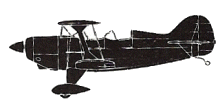
ASN Wikibase Occurrence # 168653
This information is added by users of ASN. Neither ASN nor the Flight Safety Foundation are responsible for the completeness or correctness of this information.
If you feel this information is incomplete or incorrect, you can submit corrected information.
| Date: | Tuesday 12 August 2014 |
| Time: | 11:52 |
| Type: |  Pitts S-2B |
| Owner/operator: | Private |
| Registration: | N50XV |
| MSN: | 5109 |
| Year of manufacture: | 1987 |
| Total airframe hrs: | 918 hours |
| Engine model: | Lycoming AEIO-540-D4A5 |
| Fatalities: | Fatalities: 0 / Occupants: 2 |
| Aircraft damage: | Substantial |
| Category: | Accident |
| Location: | Siesta Key, FL -
 United States of America United States of America
|
| Phase: | En route |
| Nature: | Training |
| Departure airport: | Sarasota, FL (SRQ) |
| Sarasota, FL (SRQ) | |
| Investigating agency: | NTSB |
| Confidence Rating: |
The flight instructor reported that, during a preflight inspection of the aerobatic airplane, he noted that it had about 15 gallons of fuel on board. After about 45 minutes of instructional aerobatic flight, the engine lost total power. The flight instructor chose to perform a forced landing to a beach, and, during the landing roll, the airplane nosed over and then came to rest inverted, which resulted in substantial damage to the fuselage and empennage.
A postaccident examination of the airframe and engine revealed no evidence of any preimpact mechanical malfunctions or failures that would have precluded normal operation. During the recovery, about 1 gallon of fuel was drained from the fuel tanks. Additionally, the fuel line was found absent of fuel. The two fuel tanks had a total capacity of about 30 gallons, 1 gallon of which was unusable. Although the pilot estimated that the engine typically consumed about 11 gallons of fuel per hour, the engine manufacturer’s Airplane Operating Manual indicated that the engine consumed about 15 gallons of fuel per hour when operated at high-power settings. Assuming this consumption rate, the airplane had about 1 hour of fuel available for the flight at the time of departure, not taking into account the fuel required for engine start, taxi, run-up, and takeoff. Given the quantity of fuel the flight instructor estimated was on board before the flight and the quantity of fuel recovered from the airplane, it is likely that the engine lost power due to fuel exhaustion because of the flight instructor’s inadequate preflight planning.
Probable Cause: A total loss of engine power due to fuel exhaustion, which resulted from the flight instructor's inadequate preflight fuel planning.
Accident investigation:
 |
|
Sources:
NTSB
Location
Media:
Another plane crash lands on a Florida beach; Pilot & passenger suffer minor injuries http://t.co/xgy8DoOtqL pic.twitter.com/tn4GUMYV9z
— WPTV (@WPTV) August 12, 2014Revision history:
| Date/time | Contributor | Updates |
|---|---|---|
| 12-Aug-2014 19:29 | harro | Added |
| 13-Aug-2014 18:57 | 78Delta | Updated [Time, Total occupants, Nature, Departure airport, Embed code, Narrative] |
| 21-Dec-2016 19:28 | ASN Update Bot | Updated [Time, Damage, Category, Investigating agency] |
| 30-Nov-2017 18:59 | ASN Update Bot | Updated [Other fatalities, Departure airport, Destination airport, Source, Embed code, Narrative] |
Corrections or additions? ... Edit this accident description
The Aviation Safety Network is an exclusive service provided by:


 ©2024 Flight Safety Foundation
©2024 Flight Safety Foundation